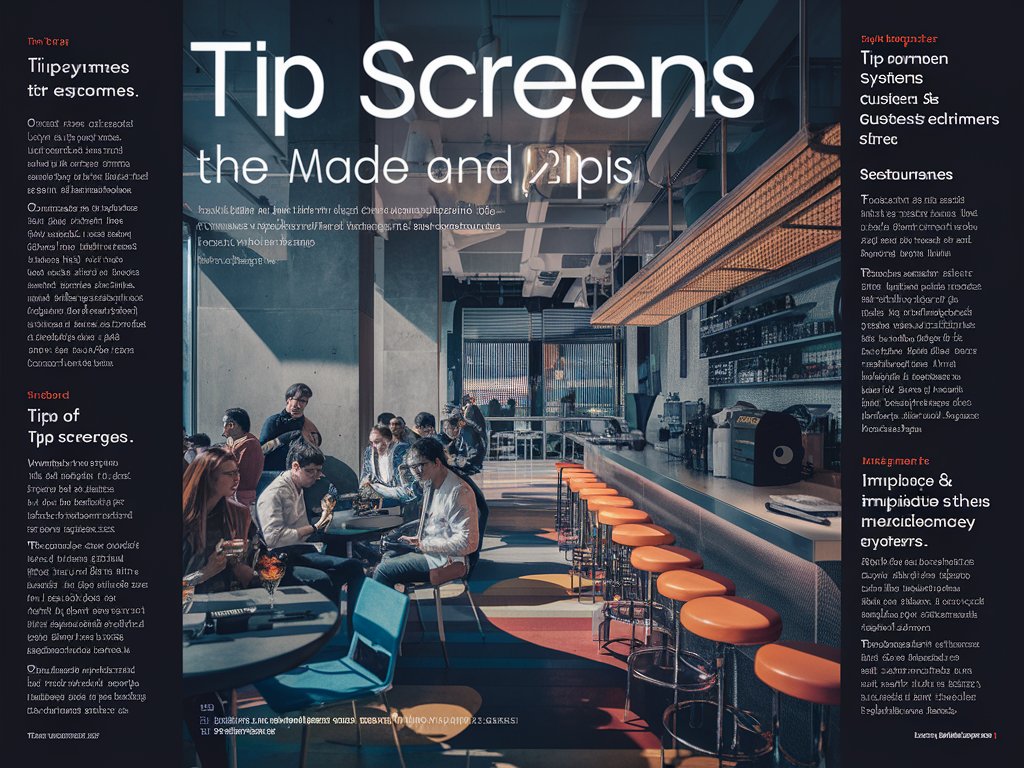The proliferation of digital payment systems has revolutionized the way businesses and customers interact. A new trend in cafes, restaurants, and service places is the use of tip screens. These screens ask customers to leave a tip after buying something, sparking a lot of talk and discussion. In this blog post, we will delve into the rise of tip screens, explore their implications for businesses and consumers, and provide practical tips for maximizing their benefits.
Introduction to Tip Screens
What Are Tip Screens?
Tip screens are digital interfaces in POS systems that ask customers to leave a tip when they finish a purchase. These screens are usually seen in places like cafes, restaurants, and salons.
These screens are commonly found in cafes, restaurants, and salons. They display tip options such as 15%, 20%, or 25%. Customers can also choose to leave a custom tip or no tip at all.
The Evolution of Tipping Practices
Tipping is a common practice in many cultures, especially in the United States. It is a way to show appreciation for good service and help employees earn more money.
Traditionally, tipping involved leaving cash on the table or adding an amount to the credit card slip. The digital age, however, has significantly changed how tipping is conducted. The advent of tip screens represents a shift towards a more automated and, some argue, more pressurized form of tipping.
Why Tip Screens Are Gaining Popularity
Several factors contribute to the popularity of tip screens.
- Convenience: Digital tipping is straightforward and eliminates the need for customers to carry cash.
- Increased Revenue for Service Workers: Tip screens often lead to higher gratuities, benefiting employees.
- Operational Efficiency: Automated tipping can streamline transactions and reduce the time spent processing payments.
- Data Collection: Businesses can gather valuable data on tipping patterns and customer behavior.
The Impact of Tip Screens on Businesses
Enhanced Employee Earnings
One of the most significant benefits of tip screens is their potential to enhance employee earnings. Research indicates that customers tend to tip more generously when prompted by a digital interface. For instance, a study conducted by Toast, a restaurant management platform, found that businesses using digital POS systems with tip prompts saw a 22% increase in average tip amounts compared to those without.
Improved Customer Experience
When implemented thoughtfully, tip screens can contribute to a positive customer experience. They provide a seamless and efficient way for customers to express their appreciation for good service. Additionally, the visibility of pre-set tip options can serve as a subtle reminder of the importance of tipping, potentially leading to more consistent gratuities.
Operational Efficiency
For businesses, tip screens can streamline operations by automating the tipping process. This reduces the likelihood of human error and minimizes the time spent on manual tip calculations. Furthermore, digital systems can integrate tipping data directly into payroll and accounting software, simplifying financial management.
Data Insights
The data collected through tip screens can offer valuable insights into customer behavior and preferences. Businesses can analyze tipping patterns to identify trends, such as peak tipping times or the impact of certain employees on tip amounts. This information can inform staff training programs and help businesses refine their service strategies.
The Customer Perspective: Pros and Cons
The Pros
- Convenience: For many customers, the primary advantage of tip screens is convenience. With the rise of cashless transactions, having an integrated tipping option simplifies the process.
- Transparency: Digital tipping ensures transparency in transactions, providing clear records for both customers and businesses.
- Encouragement for Good Service: The visibility of tip options can encourage better service, as employees know their performance directly impacts their earnings.
The Cons
- Pressure to Tip: One of the main criticisms of tip screens is the perceived pressure they place on customers. The presence of pre-set tip options can create a sense of obligation, potentially leading to uncomfortable interactions.
- Lack of Personalization: Some customers feel that digital tipping lacks the personal touch of traditional methods. The automated nature of tip screens can make the interaction feel transactional rather than genuine.
- Impact on Budget: Frequent exposure to tip screens can lead to increased spending on gratuities, which may strain customers’ budgets over time.
Best Practices for Implementing Tip Screens
Designing an Effective Tip Screen Interface
The design of the tip screen interface plays a crucial role in its effectiveness. Here are some best practices for creating a user-friendly and effective tip screen:
Simplicity: Keep the interface simple and intuitive. Avoid clutter and ensure that the tip options are easy to understand and select.
Clear Options: Provide clear and straightforward tip options, such as 15%, 20%, and 25%, along with a custom tip option and a “no tip” option.
Non-Intrusive Prompts: Ensure that the prompt for tipping is non-intrusive and does not pressure the customer. A polite and neutral language can help maintain a positive customer experience.
Training Staff
Proper training is essential for staff to understand the benefits and functionality of tip screens. Employees should be trained on how to explain the tip screen process to customers and handle any questions or concerns that may arise. Additionally, emphasizing the importance of good service and its impact on tips can motivate employees to maintain high service standards.
Communicating with Customers
Clear communication with customers is key to a successful tip screen implementation. Businesses should ensure that customers are aware of the tipping options and understand that tipping is voluntary. Signage or verbal explanations can help set the right expectations and alleviate any pressure customers might feel.
Monitoring and Adjusting
Regularly monitor the performance of tip screens and gather feedback from both customers and employees. Analyzing tipping data and customer feedback can provide insights into how the system is performing and highlight areas for improvement. Businesses should be willing to adjust their approach based on this feedback to enhance the overall experience.
Maximizing the Benefits of Tip Screens
Encouraging Generous Tipping
To maximize the benefits of tip screens, businesses can take steps to encourage generous tipping without making customers feel pressured. Here are some strategies:
Highlight Exceptional Service: Encourage employees to highlight any exceptional service they provided when presenting the tip screen. A brief mention of their efforts can remind customers of the value they received.
Provide Context: Display a brief message on the tip screen explaining how tips support the staff and contribute to their income. This can create a sense of goodwill and encourage customers to tip generously.
Offer Rewards: Consider implementing a rewards program where customers who consistently tip generously receive small perks, such as discounts or loyalty points. This can incentivize tipping while fostering customer loyalty.
Leveraging Data for Business Improvement
The data collected from tip screens can be a valuable resource for business improvement. Here are some ways to leverage this data:
Identify Peak Tipping Times: Analyze the data to identify peak tipping times and days. This information can help businesses optimize staffing levels and ensure that high-quality service is consistently provided during busy periods.
Assess Employee Performance: Use tipping data to assess employee performance and identify top performers. Recognizing and rewarding employees who consistently receive high tips can boost morale and motivate others to improve their service.
Refine Service Strategies: Analyze tipping patterns to identify areas where service could be improved. For example, if tips are consistently lower during certain shifts, investigate the reasons and implement targeted training or adjustments to address the issue.
Balancing Business Needs and Customer Comfort
While maximizing tips is beneficial for businesses and employees, it is essential to strike a balance that ensures customer comfort. Here are some tips for achieving this balance:
Respect Customer Autonomy: Emphasize that tipping is entirely optional and ensure that customers do not feel pressured to tip. Respect their decision, whether they choose to leave a tip or not.
Avoid Guilt Tactics: Avoid using guilt-inducing language or prompts on the tip screen. Instead, use neutral and informative language that clearly presents the options without making customers feel obligated.
Provide a Clear “No Tip” Option: Ensure that the “no tip” option is clearly visible and easily accessible. Customers should feel comfortable selecting this option without any hesitation.
Also Read: Snow Rider 3D Unblocked: Online Snowboarding Game
The Future of Tip Screens
Technological Advancements
As technology continues to evolve, we can expect further advancements in tip screen systems. These advancements may include more sophisticated interfaces, personalized tipping suggestions based on customer preferences, and seamless integration with mobile payment apps.
Changing Customer Expectations
Customer expectations are likely to evolve alongside technological advancements. Businesses will need to stay attuned to these changes and adapt their tipping practices accordingly. For instance, as customers become more accustomed to digital interactions, they may expect even greater convenience and flexibility in how they leave tips.
Industry Trends
Various service industries are expected to continue adopting tip screens. Tip screens are becoming more common in various industries, not just cafes and restaurants. They now work in hospitality, transportation, and personal services. Businesses in these industries can improve customer satisfaction and employee earnings by using tip screens effectively.
Conclusion
Tip screens are causing a significant shift in the way service-oriented businesses conduct tipping. While they offer numerous benefits, including enhanced employee earnings, improved customer experience, and operational efficiency, it is crucial for businesses to implement them thoughtfully. Businesses can maximize tip screens by creating user-friendly interfaces, training employees, communicating with customers, and utilizing data. This can be done while ensuring customer satisfaction.




